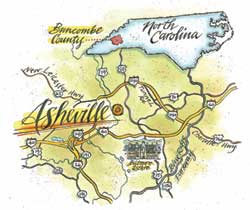
 You know a place has arrived if it grabs the attention of Robert Redford. It happened for all of Montana and its rugged landscape with "A River Runs Through It" in the early '90s. And more recently for Asheville, North Carolina, when Redford chose the mountain town as the setting for his 2004 flick, "The Clearing," with praise for the area's beauty and majesty. You know a place has arrived if it grabs the attention of Robert Redford. It happened for all of Montana and its rugged landscape with "A River Runs Through It" in the early '90s. And more recently for Asheville, North Carolina, when Redford chose the mountain town as the setting for his 2004 flick, "The Clearing," with praise for the area's beauty and majesty.
But before Hollywood descended-and long before the area's Southern charm and the surrounding 6,000-foot-high mountain peaks wowed visitors-Asheville was a sleepy hamlet. Indeed, weeds poked through the sidewalks, boards covered vacant storefronts and streets rolled up at sunset. Then about 20 years ago, boomtown fever hit, and Asheville bolted upright from its nap to achieve rock-star status, making the cover of Rolling Stone as a cool spot to get in touch with your inner hipster and praised by Modern Maturity as one of America's most desirable places to retire.
The stage was set for the recent stirrings over a century ago when George Vanderbilt came to town and created Biltmore Estate. (George wasn't much different than the people flocking to Asheville nowadays who've decided to ditch the rat race for mountain views.) To build his home and now-popular tourist destination, artisans and architects from all over Europe moved to Asheville to work on the project. While working on the Vanderbilt dream, they also gave the town an architectural facelift seen in the Art Deco city courthouse and magnificent Basilica St. Lawrence-to name just two of the many gorgeous buildings.
It's a renewed appreciation for this antique architecture and, of course, the natural beauty that goes along with being in the mountains that's part of the reason for all the commotion. It also doesn't hurt that there's an artistic and cultural renaissance underway, which has paved the way for outstanding theatre, musical and visual arts programs and events.
Age-Old Appeal
Despite this sudden popularity, locals have long been aware of Asheville's appeal to people of all ages and walks of life. First and foremost, it's a mountain town with modest roots. Sandwiched between the Smokies and the Blue Ridge, the downtown's main boulevards-now lined with cafes and bistros-were initially carved out by herds of indigenous buffalo that migrated through the region and used as hunting trails by the Cherokee. Later, explorers established a trading post, and the town began to grow and develop as a center for livestock markets. Boarding houses opened, travelers stopped and settled down as permanent residents and the city grew. History has a way of repeating itself, and modern-day newcomers flock to the area in search of an easier, laid-back and more-fulfilling lifestyle.
For longtime residents, cultural preservation is a critical issue. That's why you'll find mountain crafts mingling with avant garde exhibits and the latest in trendy cuisine competing with one of the towns' oldest restaurants, The Mediterranean, which is a traditional Appalachian diner. It's a favorite spot for a down-home meal served up with a helping of Southern hospitality. And while there's always a new play to see or concert to take in, this is still a place where you can opt for a night at the ballpark to cheer on the Tourists, Asheville's minor-league team. Or you can enjoy a sunset meal in the mountains with take-out from Picnic's, a small, family-run establishment.
Still a Small Town
It's this simple lifestyle, with all of its flavors and many wonderful traditions, that's the real draw to Asheville and the surrounding area.
It certainly appealed to Susan and Jim Wade when they decided to build their log home in a rural area outside of the city limits. "You have a really neat city with cultural opportunities within easy reach of mountain living," says Susan.
According to Asheville native and log-home builder, Al Pierce, folks are looking east and north of town to find large, reasonably priced tracts of land. (About 75 percent of them are for full-time residents, and the rest are vacation properties.) Deals can still be found in almost any direction the crow flies.
Real-estate broker Carrie Welles Miller, who has seen quite a few log homes go up west of Asheville, agrees. "Land tends to be a bit more affordable out there," she explains. "Many of the folks who purchase log homes will set them up as "perchers," high in the hills where the views are spectacular, but the land is cheaper." (Her company-The Buyers Agent of Asheville-works with log home buyers.)
Stunning views from their 6-acre mountainside lot clinched the deal for Susan and Jim. "Asheville just seemed to speak to us," says Susan. Jim adds: "We believe the chamber of commerce is onto something with its motto, Altitude Affects Attitude."
And with a mountain perch, we're talking one healthy attitude.
| Just the Facts: Asheville, North Carolina |
|
Population: Buncombe County 214,572
Asheville City about 69,000
Tax rate: $0.59 per $100 assessed valuation
Average household income:
Buncombe County $39,600
Asheville City $35,500
Average sale price for existing home: $239,000
Average sale price for 3 bedroom/2 bath existing log home: $252,500
Vacant land (according to realtors and builders surveyed): $5,000 and up per acre for larger tracts in the countyside; $25,000 and up per acre for land within the Asheville city limits.
|
Tom Kerr is a travel writer based in Alexander, North Carolina.
|


